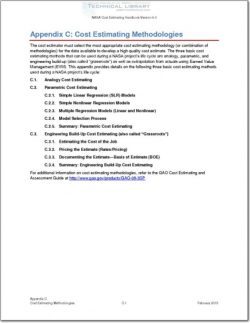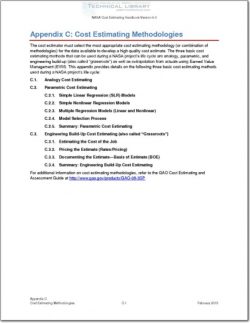NASA-CEH-APP-C

- Version
- 230 Downloads
- 1.20 MB File Size
- 1 File Count
- August 14, 2016 Create Date
- August 14, 2016 Last Updated
Appendix C; Cost Estimating Methodologies

Appendix C: Cost Estimating Methodologies
The cost estimator must select the most appropriate cost estimating methodology (or combination of
methodologies) for the data available to develop a high quality cost estimate. The three basic cost
estimating methods that can be used during a NASA project’s life cycle are analogy, parametric, and
engineering build-up (also called “grassroots”) as well as extrapolation from actuals using Earned Value
Management (EVM). This appendix provides details on the following three basic cost estimating methods
used during a NASA project’s life cycle:
C.1. Analogy Cost Estimating
C.2. Parametric Cost Estimating
C.2.1. Simple Linear Regression (SLR) Models
C.2.2. Simple Nonlinear Regression Models
C.2.3. Multiple Regression Models (Linear and Nonlinear)
C.2.4. Model Selection Process
0.2.5. Summary: Parametric Cost Estimating
C.3. Engineering Build-Up Cost Estimating (also called “Grassroots”)
C.3.1. Estimating the Cost of the Job
C.3.2. Pricing the Estimate (Rates/Pricing)
C.3.3. Documenting the Estimate—Basis of Estimate (BOE)
C.3.4. Summary: Engineering Build-Up Cost Estimating
For additional information on cost estimating methodologies, refer to the GAO Cost Estimating and
Assessment Guide at http://www.qao.qov/products/GAO—OQ—BSP.
Appendix C
Cost Estimating Methodologies 0-1 February 2015
NASA Cost Estimating Handbook Version 4.0
Figure 0-1 shows the three basic cost estimating methods that can be used during a NASA project’s life
cycle: analogy, parametric, and engineering build-up (also called “grassroots”), as well as extrapolation
from actuals using Earned Value Management (EVM).
When choosing a methodology, the analyst must remember that cost estimating is a forecast of future
costs based on the extrapolation of available historical cost and schedule data. The type of cost
estimating method used will depend on the adequacy of Project/Program definition, level of detail
required, availability of data, and time constraints. The analogy method finds the cost of a similar space
system, adjusts for differences, and estimates the cost of the new space system. The parametric method
uses a statistical relationship to relate cost to one or several technical or programmatic attributes (also
known as independent variables). The engineering build-up is a detailed cost estimate developed from
the bottom up by estimating the cost of every activity in a project’s Work Breakdown Structure (WBS).
Table 0-1 presents the strengths and weaknesses of each method and identifies some of the associated
applications.
| File | Action |
|---|---|
| NASA-CEH-APP-C Appendix C; Cost Estimating Methodologies.pdf | Download |

Comment On This Post